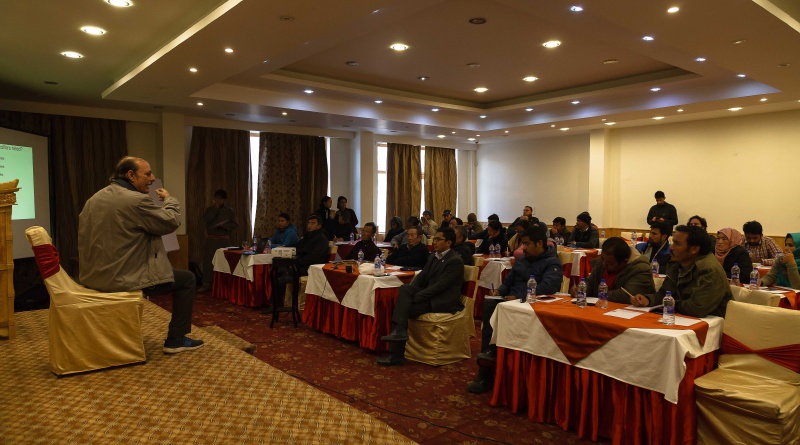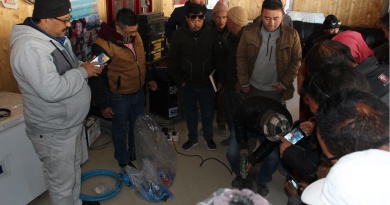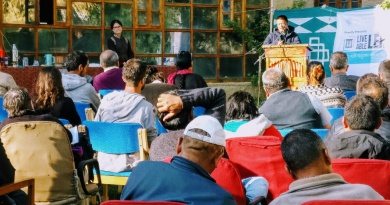Municipal Workshop
Orientation workshop for Municipal Committee members on Municipal Committee – Its Roles and responsibilities Activity Orientation workshop to Municipal Committee members on Municipal Committee - It Roles and responsibilities. Date 29th & 30th November 2018 Venue LEDeG office and site visits Members present Elected Municipal Committee members of Kargil and Leh
With new Municipal Committee members elected for Leh and Kargil, there would certainly be transfer of responsibilities from the current city administrative officers to the elected representatives. This change is very critical for both the towns, as there are many projects that are active and currently being implemented on the ground, which require close monitoring along with addressing day-to-day issues faced by the citizens of the towns and plan for future developments. With many young and first-time elected members assuming the power, it would be challenging for the members to understand their roles and responsibilities in a very short span of time and respond immediately to the issue of the town.
Apart from the pace of developmental projects in these cities the elected members will also have an important responsibility to shape up their towns for the future. Also the vision of their respective towns should be in consonance with realities of the region. The elected representatives will have to play a major role in shaping this vision in collaboration with the people. The collaborative approach needs to be comprehended, assimilated and disseminated.
Ladakh Ecological Development Group (LEDeG) in collaboration with Ladakh Autonomous Hill Development Council (LAHDC) Leh organized a two-day orientation workshop on Municipal Committee- its roles and functions, under the Liveable Leh project, which is supported by the European Union and co-funded by BMZ, at the Hotel Singge Palace in Leh on November 29 and 30. The newly elected members of Municipal Committee Leh and Kargil attended the workshop. Chief Executive Councilor9 of Ladakh Autonomous Hill Development Council (LAHDC) Leh Jamyang Tsering Namgyal and Deputy Commissioner Leh Ms Avny Lavasa were the guests for the occasion.
Sessions and activities conducted during the workshop Day 1 (29th November 2018)
The Workshop was inaugurated by Shri Jamyang Tshering Namgayal, Chief Executive Councilor of Ladakh Autonomous Hill Development Council and has briefed the participants on the importance of the orientation workshop and having a clear idea on the roles they would be assuming for the next few years.
Later Prof. V.K. Dhar, former professor at National Institute of Urban Affairs has started the sessions on explaining the participants on what constitutes an urban area and how are they constituted. Prof. Dhar also explained the committee members on the importance of women in municipal committee and suggested that Municipal committee members need to have a platform across the region to help them resolve their issues and share ideas for improvement of their respective constituencies.
Dr Mukesh Mathur informed the participants about the 74th Constitutional Amendment. The 74th Amendment gives complete autonomy to urban bodies like corporations and municipalities. It states that they should be able to manage on their own, and shouldn’t be a subsidiary of the state government. He said that Dharavi in Mumbai is a perfect
LiveableLeh
LEDeG | August 21 MCL Workshop Report|2/8
example of urbanism in India and termed it as a self-contained urban area. Dr Mukesh shared that Rajiv Gandhi, who is credited with laying the foundation of Panchayati Raj institutions in order to take democracy to the grassroots level and also gave impetus to the 74th Constitution Amendment, sanctioned a grant of Rs 100 crore to Bombay, of which a substantial amount was allocated to Dharavi to redevelop some of its parts.
Dr Mukesh also added that the recommendations of the 14th Finance Commission are still prevalent in parts of India. He informed the participants about the overlapping of functions between the District Planning Committee (DPC) and Metropolitan Planning Committee (MPC). He said the role of development authorities and parastatal bodies in the new set-up is not defined. Mr Mathur observed that the Jawaharlal Nehru National Urban Renewal Mission (JNNURM) has listed down 23 mandatory reforms, but the majorities are yet to achieve those goals.
Mr Fyaz Ahmed, chief town planner of Jammu and Kashmir, spoke about the role of Municipal Committee members, the role of the executive, and salient features of Jammu & Kashmir Municipal Act 2000. He said that only five towns from Jammu and Kashmir qualified for AMRUT schemes, including Leh and Kargil. He shared that there should be a representative-possibly from the Municipal Committee of Leh and Kargil, to build upon the central governmentfunded scheme.
He also requested the organisers of the event to simplify the J&K Municipal Act 2000. He said that despite being termed as one of the most beautiful places on earth, Srinagar stands at 100th rank in the most desirable places to visit. He said that it showed the flaws in the city. He said it is the responsibility of the members of Municipal Committee to meet the expectations of the people and provide better services.
He also stressed the need to have a Master Plan for the city. He said that although Kargil has already prepared a Master Plan, it could still be improved. Fyaz said that tax collection and generation of revenue should be the priority of the Municipal Committee members. He also encouraged the Municipal members to collect taxes from the tourists visiting Leh and asked them to use that money for the development of the town. He further added that the Town Planning Organising department of the state has invited tender for the Leh Master Plan.
Mr Tikender Panwar has detailed out on how elected representatives shape the vision of the town and why is it necessary for the committee members to understand and formulate a vision for a town and provided few examples on how elected representatives have shaped cities in India and abroad.
Later Mr Moses Kunzang and Mr Sonam Chosjor have provided a few insights on the important activities that their towns have taken up till now and what challenges lie ahead for the committee members to work on. Later the committee members have been divided into groups for a group visioning exercise. The members formed into groups of 6 members each and two groups of each town and developed list of priority issues the groups would work on.
List of priority issues prepared by groups
Group 1 - Kargil Group 2 Kargil Group 1 Leh
Group 2 Leh Check Unplanned construction Develop Public toilet Solid waste Management Water Conservation Solid waste Management Town beautification Electricity Forming an engineering wing Mobility Integrated Water management Road connectivity Improving civil amenities Main market vehicle free Slaughter house provision Integrated Water management Reduce traffic congestion Water supply to each household Developing parks Traffic Congestion Stray animals management River front development Road connectivity to Kargil Stray Animals management
Later the priority areas listed out by the groups have been discussed by its members and the group activity was concluded by the Mr Tikender Singh
LiveableLeh
LEDeG | August 21 MCL Workshop Report|3/8
The penultimate session was taken by Professor Mukesh Mathur as he talked about understanding municipal finance for small municipalities. He shared with the participants the major sources of income for ULBs, including taxes and non-taxes, grants, etc. He said that the municipal committee has to consider the selection of value capture financing (VCF) tools and also take care of the budget. He also talked about different types of budgets.
The first day ended with a session on happy cities by Mr Sonam Wangchuk. He screened a video on happy cities and then asked the participants to list down the things which they like and dislike about Leh and Kargil towns. He said that Leh is an example to other Himalayan cities and the only solution to overcome the problem of rampant urbanisation was to create a twin city. He also made certain recommendations to make Leh an attractive city: maintain and preserve the USP of Ladakh, houses should be powered by solar energy and windows should have double wall to trap the solar heat.
Day 2 (20th August 2018)
Day 2 began with a session on the 74th Constitutional Amendment by Mr Anirudh Singh and Ms Evita Das from Indo Global Social Service Society. They talked about the Nagar Raj Bill Act, Mohalla Sabha, the constituency of Mohalla Sabha, Mohalla Committee- its functions, duties and powers, and ward committee.
Mr Manas Rath from BORDA took a session on the importance of water supply and the role of a committee member in which he also talked about the current water scenario in Leh and how Leh town is currently using ground water in Leh and what can be done in future for better integrated management of water supply in the town.
Mr Tikender Panwar and Mr Manas Rath have later conducted a session on how to manage utilities. Both of them talked about financial resources, tariff, key performance indicator (KPI), objectives and delegated management model for maintaining a utility. Mr. Tikdender provided examples on how Shimla worked in its water problem and how small towns incur a lot of charges lifting water from source far away from town. The two also discussed alternatives on various local issues such as the Indus River, water freeze in winters in Ladakh, and storage capacity of the tanks.
Mr Rigzin Spalgon, the administrator of Municipal Committee Leh, shared the Leh story with the participants. He talked about the functioning of toilets in peak tourist seasons and winters, construction of public parks- lessons learnt from mistakes. Mr Spalgoan explained the design process involved for re-developing Changspa Street.
Post-lunch, the participants went for a field visit to FSTP at Bomb Garh, Changspa Street and the public convenience at Zangsti.
Mr Anuj Malhotra took the last session as he talked about mobility and administration. He shared the details and designs on Changspa Street. He added that pedestrians should be given priority ahead of cars and the need to connect the intersections to connect the loop around Leh town. He said the center of Leh town should be completely pedestrian friendly, but also conceded the challenges to achieve the objective. He also advised the Municipal members to work on a comprehensive mobility plan of Leh town.
Lastly, Ms Avny Lavasa, Deputy Commissioner Leh, joined the workshop and shared that the Municipal members should make the most of the workshop and she exuded confidence that the new Municipal team will perform well. She said the benefit of local people would be decided by Municipal Committee and also stressed the need to prepare a vision document


